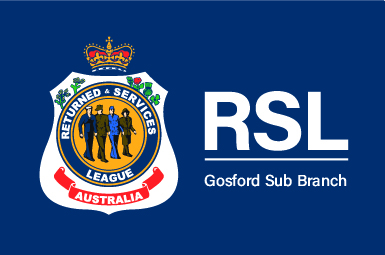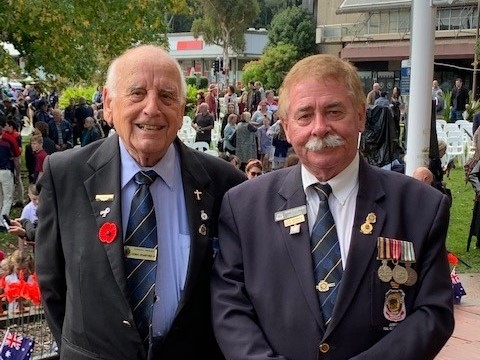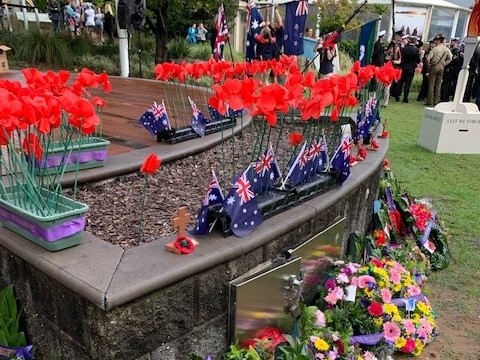
Meetings
The Gosford RSL Sub Branch meets at Gosford RSL Club on the first Sunday of each month at 10am (excluding September when it is held on the second Sunday.) No meeting in January.




ANZAC Day, the 25th of April each year, is the day Australia commemorates with services and marches in cities and towns and throughout the world where servicemen, servicewomen and peacekeepers are stationed, to remember all those who lost their lives in service to their country, in all wars. The date of the landing at ANZAC, the 25th April was chosen to be the day that would become our national day of commemoration.
Initially, ANZAC day was a mark of respect for those who served and sacrificed their lives in the Great War for Civilisation, the war as many hoped, to end all wars. However, because of the vicissitudes of man, the date has become the day on which the nation remembers those who served and those who made the ultimate sacrifice in all the conflicts that Australia has participated up to the present day in the continuing struggle to preserve our freedoms in the attempt to rid the world of tyranny.
ANZAC, originally an acronym for the Australian and New Zealand Army Corps, that was used by the clerks of General Birdwood's staff at his headquarters in Shepheard's Hotel in Cario, Egypt. The word ANZAC was approved by General Birdwood as the code for the Corps, when the word was proposed by a Major CM Wagstaff. It is thought the suggestion came from a Lieutenant AT White of the Royal Army Service Corps. It is recorded in the official history that "it was some time before the code word came into general use, and at the Landing (on the 25th April, 1915) many men in the divisions had not heard of it". After the landing, General Birdwood gained permission to use the name for the area occupied by the Australian and New Zealand Forces.
At ANZAC on the Dardanelles Peninsula, Australian and New Zealand troops landed on the 25th April 1915 where they, along with other Commonwealth Forces, held ground against almost impossible odds for the next eight months, against a Turkish force determined to defend to the death their homeland. The British action planned to secure the heights overlooking the forts guarding the narrow straits at the entrance to the Sea of Marmora. The purpose to silence them and allow the French and British Navy to proceed to Constantinople (now Istanbul) and by a show of force convince the Turkish Government to capitulate and to come on the side of the Allies.
The plans did not bear fruit and what ensued was a tremendous series of battles by both sides over the next eight months. It was all the British forces (of which the Australian and New Zealand force were a part), could do to hold ground against a Turkish army determined to drive them into the sea. It was a battlefield where no one, not even General Birdwood and his staff were safely out of the range of Turkish guns. The odds against them were tremendous, but they held on repulsing many Turkish counterattacks in conditions of hardship that tested the hardiest. Both sides suffered horrendous casualties amongst the many ravines and gullies of that rugged battleground on which the ANZAC tradition was formed and that has become the benchmark for standards of courage, mateship, humour and a determination to complete a given task, and has set an example for all Australians to follow whenever faced with difficulties.
The ANZACs, as they became known went on to continue that tradition on the Western Front and Palestine throughout the 1914 – 1918 conflict where conditions at times were a greater trial than at ANZAC. In that war the first Australians fought and proved themselves as a Nation to be reckoned. ANZAC forces in the field suffered over 270,000 casualties of which in excess of 78,000 Australians and New Zealanders were either killed in action or died of wounds. There have been many more since.
The Price of Liberty is Eternal Vigilance
We Will Remember Them
Lest We Forget
At 11 am on 11 November 1918 the guns on the Western Front fell silent after more than four years of continuous warfare. The allied armies had driven the German invaders back, having inflicted heavy defeats upon them over the preceding four months. In November the Germans called for an armistice (suspension of fighting) in order to secure a peace settlement. They accepted allied terms that amounted to unconditional surrender.
The 11th hour of the 11th day of the 11th month attained a special significance in the post-war years. The moment when hostilities ceased on the Western Front became universally associated with the remembrance of those who had died in the war. This first modern world conflict had brought about the mobilisation of over 70 million people and left between 9 and 13 million dead, perhaps as many as one-third of them with no known grave. The allied nations chose this day and time for the commemoration of their war dead.
On the first anniversary of the armistice in 1919 two minutes' silence was instituted as part of the main commemorative ceremony at the new Cenotaph in London. The silence was proposed by Australian journalist Edward Honey, who was working in Fleet Street. At about the same time, a South African statesman made a similar proposal to the British Cabinet, which endorsed it. King George V personally requested all the people of the British Empire to suspend normal activities for two minutes on the hour of the armistice "which stayed the worldwide carnage of the four preceding years and marked the victory of Right and Freedom". The two minutes' silence was popularly adopted and it became a central feature of commemorations on Armistice Day.
On the second anniversary of the armistice in 1920 the commemoration was given added significance when it became a funeral, with the return of the remains of an unknown soldier from the battlefields of the Western Front. Unknown soldiers were interred with full military honours in Westminster Abbey in London and at the Arc de Triumph in Paris. The entombment in London attracted over one million people within a week to pay their respects at the unknown soldier's tomb. Most other allied nations adopted the tradition of entombing unknown soldiers over the following decade.
After the end of the Second World War, the Australian and British governments changed the name to Remembrance Day. Armistice Day was no longer an appropriate title for a day which would commemorate all war dead.
In Australia on the 75th anniversary of the armistice in 1993 Remembrance Day ceremonies again became the focus of national attention. The remains of an unknown Australian soldier, exhumed from a First World War military cemetery in France, were ceremonially entombed in the Memorial's Hall of Memory. Remembrance Day ceremonies were conducted simultaneously in towns and cities all over the country, culminating at the moment of burial at 11 am and coinciding with the traditional two minutes' silence. This ceremony, which touched a chord across the Australian nation, re-established Remembrance Day as a significant day of commemoration.
Four years later, in 1997, Governor-General Sir William Deane issued a proclamation formally declaring 11 November to be Remembrance Day, urging all Australians to observe one minute's silence at 11 am on 11 November each year to remember those who died or suffered for Australia's cause in all wars and armed conflicts.

The Gosford RSL Sub Branch meets at Gosford RSL Club on the first Sunday of each month at 10am (excluding September when it is held on the second Sunday.) No meeting in January.

As part of the Returned & Services League of Australia (New South Wales branch), our sub-Branch is dedicated to the care, health and wellbeing of returned and ex-members of the Australian Defence Force, Australian Merchant Navy, and their dependants. This is a key part of our mission and core business.
Contact Gary Young
0404 471 094 Welfare assistance

Join a community of Veterans and their families. Complete the form and present to the Gosford RSL reception or post to Gosford RSL Sub Branch 26 Central Coast Hwy West Gosford.

For all the latest news go to https://www.rslnsw.org.au/news/